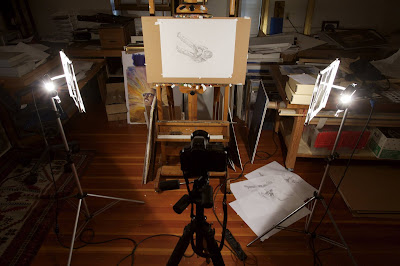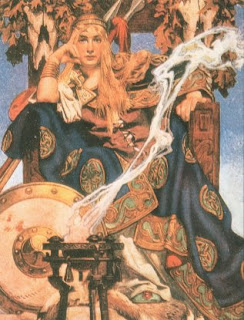Wednesday, February 04, 2009
1) Don't give me your postcard and then take it back to cross out your web address because "the work there isn't good."
2) Don't let me flip through half a portfolio and then stop me mid way to say "the rest is older work, you're probably not interested, and it's not good anyway."
3) Don't show me one, and only one, image on an iPhone. In fact, unless you know I am very familiar with your work, don't show me an iPhone portfolio at all.
4) "Hello, my name is.....We're MySpace friends." Followed by silence thinking I'm going to remember you off the top of my head. Hell, I can hardly remember the names of people I actually meet.
5) 35mm slides!? I didn't think you could buy slide film anymore.
Guys, you’re at ComicCon. Chances of running into an art director are, well, high. You didn't just happen to run into the ADs for every major gaming, comic, movie, and publishing companies at a neighborhood barbecue, so get your ducks in a row before making that first impression.
Wednesday, December 03, 2008
Monday, November 03, 2008
Thursday, October 09, 2008
Photography of reflective (flat) art



Some info on the tricky business of photopraphing artwork, from a recent workshop at CCA:
EQUIPMENT
Camera:
Manual control slr, (film or digital- although the thrust of this talk is digital, these principles can be applied to film)
Ideal features in a DSLR camera: white balance control, manual focus, manual control of aperture and shutter. Good to have: mirror lock up, depth of field preview, self timer or cable /remote release, RAW file support. Ideally no multiplier 1:6 is typical. Cameras with full-frame sensors are expensive but becoming more common:
Point and shoot cameras are useful for street photography and family gatherings but don’t work well for shooting artwork, because of parallax and lack of manual control.
Good cameras: Canon eos 30D, eos 40D, eos50D, eos 5d, eos5dmk2. (I use a 7 year old Canon EOS d60, a relatively primitive DSLR which works quite well.)
Corresponding Nikons are also good. D90 may be exceptional value . Buy what is comfortable for you.
Lens: 50-60 mm prime macro lens is ideal on SLR camera. Zoom or wide angle produces barrel distortion..
Polarizing filter for lens. Critical.
Support: 2 light stands. Make your own w/ Pvc pipe/ superclamps?
Tripod: Star-D is good and cheap. Used tripods are easy to find.
Lighting :
3200k photoflood lamps, homemade from ceramic socket and home depot bells, or lowel- tota/omni – lights no dimmers. 500 watts. Check for color changes.
Super clamps- let you clamp things to other things.
If there is any glare or shine on your work, you need polarizing filters for lights and lens
10x12 polaroid filters for lighting are essential. Polarizing filters remove light polarized at 90° to the filter's polarization axis.
Filter holders for lowel lights or other clamps- home depot clamps/ hold filters 6-8 inches from light. Many available from bhphotovideo.com.
OTHER
Kodak color bars, grey card
Measuring tape. Level may be useful. Duct tape, white tape.
Software: Photoshop, Aperture (or iphoto or lightroom)
Backup drives,
power strip w/ switch.
Shooting
Aperture: f8 , balance speed and depth of field
Artificial light: generally if possible, use artificial light because you can have more consistent results.
Digital: set ASA at 400 ok but test for noise, Film: asa 64 tungsten ektachrome
Digital camera white balance: tungsten (light bulb icon)
Place camera level w art at horizontal. Measure height of lens center and art center w tape.
Make sure art is level, square and flat. Very important. Devise way to hold art flat.
Place lights each at 45 degree angle to art, with polarizers with axis parallel to the floor. Check illumination by placing shadow at center of art, should be equal shadows l/r. Get even illumination, no hot spots or shadows.
Tape color bars to edge of art in live area.
Set ASA (digital) to no more than 400.
Set file type to RAW.
Set light to tungsten.
Square up camera to art, try to get everything clean, in focus. Focus with polarizer off.
Turn on pola on lens, check focus.
Set camera for f8, take reading off gray card, adjust for EV of cray card. Recheck focus, Lock up mirror, put on timer release, shoot and bracket 1/2 stop each way. Turn off lights- polarizers can burn.
Review results, adjust exposure as necessary. Use post-its on art to note test conditions.
Unplug everything when your done…fire hazard.
Do the same with film, but use tungsten ektachrome.
Resources:
http://www.metacafe.com/watch/1566782/making_homemade_light_stands_for_under_10/
clamp light
http://www.bhphotovideo.com/bnh/controller/home?O=1366&A=details&Q=&sku=262758&is=REG&addedTroughType=categoryNavigation#
bhphotovideo.com is best online resource for equipment.
-Robert Hunt
Friday, November 09, 2007
Lyendecker lecture





An interesting lecture podcast on JC Leyendecker. It makes good background listening...
http://www.hagginmuseum.org/exhibitions/leyendecker/lecture.html
He was one of the most influential and successful American illustrators of the twentieth century, sitting atop of the profession at a time when there were innumebrable great artists working in the field. His paintings are amazing combinations of draughtsmanship and bravura painting technique.
Wednesday, October 03, 2007
Irene Gallo Interview

Irene Gallo is the art director of Tor Books. She is certainly one of the biggest supporters of illustration in the publishing industry.
This interview originally appeared on Fantasybookspot.com
damon: I was finally able to get in touch with Irene, as she has a very busy schedule. This interview was all prompted from meeting Irene at last year's New York Comic Con where I think I interrupted her lunch. Being the courteous person that I am, I figured I would let her finish lunch and track her down a bit later. That bit later took some stalking on my part and some annoying emails. I think Irene ended up finishing this interview just so I would not bother her anymore. All joking aside though I am very happy to introduce Irene Gallo, the Art director for Tor, Forge, and Starscape Books. I also want to thank Nicole Cardiff, one of my favorite young fantasy artists, who helped me with the questions for this interview.
Question: Let the readers know what you job consist of? What sort of work does being an art direction consist of?
Irene: It's my job to get all of Tor's book jackets created. I juggle the concerns of the Editorial department and the Sales & Marketing department to try and come up with a jacket that everyone likes. It's a lot of management work, but I'm always working with creative people and ideas. There is a lot of illustration used in science fiction and fantasy and by far the most enjoyable part of my job is working with the illustrators.
Question: Where did you go to art school?
Irene: Cooper Union. I was very lucky. Foolishly, it was the only school I applied to. I wanted to go there because it was considered and excellent art school, located in downtown Manhattan, and free. Once there I took a typography class on a whim and found that I really loved the problem solving of design.
Question: Do you find yourself not being able to enjoy art because it is your job?
Irene: Not at all. In fact, if anything I enjoy it even more. I have a much more intimate reaction to art knowing some of issues these guys struggle with. I think things are even more magical when I have a little insight into how they are made and knowing how difficult it is to make something seem effortless.
What _is_ unfortunate is that between Tor and volunteering at the Society of Illustrators I don’t have the time to read as much as I used to. I skim the first handful of manuscript pages and then something else is overdue and needs attention.
Question: Do you have to go out and find new talent or does it find you.
Irene: Both. I spend a whole lot of time looking for artists -- in bookstores, annuals (like Spectrum), online forums (like Conceptart.org), conventions, magazines, wherever I can. When I see a book cover, I want to know who did it -- whether I like it or not, I want to know who’s out there and what they are doing.
I also get lots and lots of mail. When I first started I would get portfolio drops a few times a week, nowadays printing has become so cheap that people send me tons of postcards and other mailers. Sometimes I get unsolicited email but that is fairly intrusive. It might lead me to their website, but only if I am really trying to avoid work.
I find a surprising amount of artists through recommendations by other artists. It’s a very supportive and giving community.
Question: What does a normal mail day for Irene look like when you are in the office?
Irene: Normal? You know I work at Tor, right?
Actually, it is all terribly normal...just with more interesting people than your average office. Lots of meetings, lots of figuring out deadlines and then complaining when they are not met, tons of email with artists. Begging editors for information. Begging artists to meet deadlines. Slinking away from Sales when I don’t have a cover ready.
Question: Do you read the book?
Irene: We publish hundreds of books each year so, unfortunately, I cannot read them. I rely on a series of conversations with the editors to get a sense of the book. Author blogs are a big help to get a feeling for someone’s work. Once I feel like I have a handle on the tone of the book I’ll pick a few artists and then talk to the editor and see if I’m heading in the right direction. Some artists like to read the books, and that’s a big help. Sometimes an editor will talk about the most pivotal scenes that may not be the most visual.
Question: How hard is it to match the author's vision of a character to the book? What about the people that say that's not what the character looked like? What would you say is the best cover matching story artwork?
visit Fantasybookspot.com to read the rest of this interview







